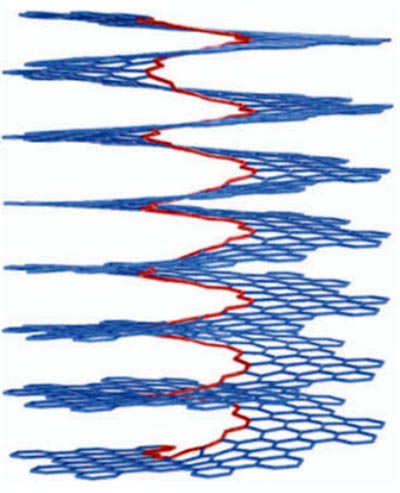Researchers synthesize carbon nanosolenoid with Riemann surfaces

Illustration of CNS with Riemann surface. Image by WANG Jinyi et al.
It is known that Albert Einstein constructed equations of general relativity by adopting Riemann geometry. In addition to the key role it played in mathematics and physics, Riemann geometry has provided predictions for the properties of curved carbon materials. However, synthesis of such complicated carbon materials with Riemann surfaces has remained to be a great challenge.
In a study published in Nature Communications, a research team led by Prof. DU Pingwu from the University of Science and Technology of China (USTC) of the Chinese Academy of Sciences, reported a facile synthesis of π-extended nanographene carbon nanosolenoid (CNS) material. The material consisted of continuous spiral graphene planes, as was typical of Riemann surface. The CNS displayed special photoluminescence and magnetic properties.
To obtain the material, researchers first synthesized polyphenylene precursor (P1) through a Pd-mediated Suzuki coupling, then conducted Scholl reaction as the cyclodehydrogenation step. They confirmed the existence of CNS by identifying changes in solid-state nuclear magnetic resonance (NMR) and Fourier transform infrared (FT-IR) spectrum between P1 and CNS.
Due to its extended π-conjugation, CNS exhibited red-shifted emission band compared with P1. The lifetimes of P1 and CNS also differ as measured by the time resolved photoluminescence (TRPL) technique, indicating the influence of large π-conjugation in CNS.
Conventional TEM, because of its high energy output, would cause structural damage to CNS. Thus, researchers adopted a low-dose integrated differential phase contrast scanning transmission electron microscopy (iDPC-STEM) and observed single-stranded CNS helix. The observed helical pitch and width well matched that of the calculation.
Researchers then studied the magnetic and electronic properties of CNS. As demonstrated by electron paramagnetic resonance (EPR) spectroscopy, a large number of radicaloids existed in CNS at room temperature. Superconducting quantum interference device (SQUID) magnetometry indicated a magnetization memory effect below 150 K. Additionally, a large thermal hysteresis could be observed below 10 K as a result of breaking of π-electrons due to the helix structure.
This work introduced a facile synthetic approach of CNS with Riemann surfaces, and made it possible to study the novel physical properties of such materials.
Journal: Nature Communications
DOI: 10.1038/s41467-022-28870-z
Article Title: Synthesis of a magnetic π-extended carbon nanosolenoid with Riemann surfaces
Article Publication Date: 9-Mar-2022
Media Contact
Jane fan
University of Science and Technology of China
qfan@ustc.edu.cn
All latest news from the category: Materials Sciences
Materials management deals with the research, development, manufacturing and processing of raw and industrial materials. Key aspects here are biological and medical issues, which play an increasingly important role in this field.
innovations-report offers in-depth articles related to the development and application of materials and the structure and properties of new materials.
Newest articles

Hubble Views the Dawn of a Sun-like Star
Looking like a glittering cosmic geode, a trio of dazzling stars blaze from the hollowed-out cavity of a reflection nebula in this new image from NASA’s Hubble Space Telescope. The…

Engineering a new color palette for single-molecule imaging
A new paper published in Nature Nanotechnology outlines a way to create dozens of new “colors” to multiplex single-molecule measurements. Researchers often study biomolecules such as proteins or amino acids…

Using solar energy to generate heat at high temperatures
The production of cement, metals and many chemical commodities requires extremely high temperatures of over a thousand degrees Celsius. At present, this heat is usually obtained by combusting fossil fuels:…





















